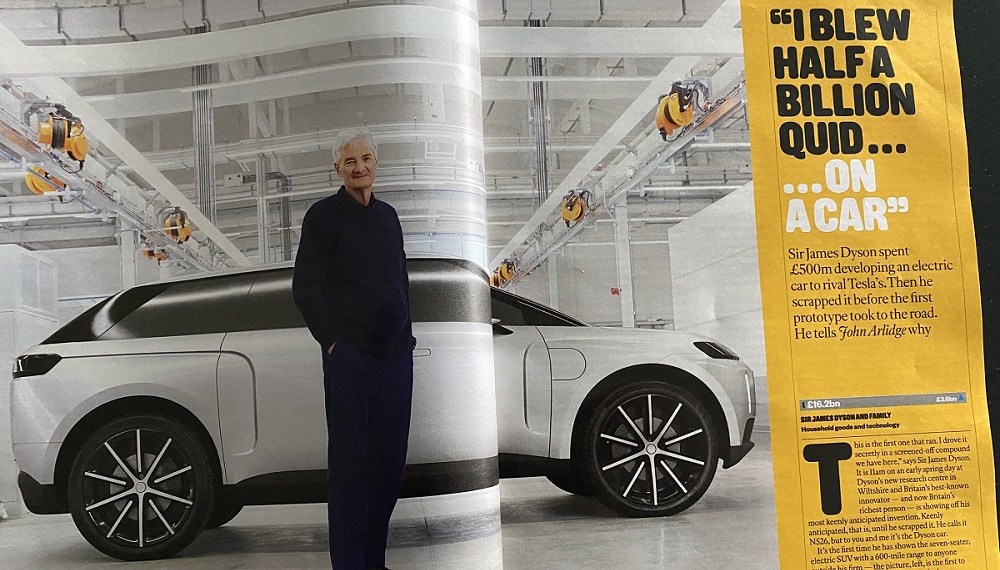Did you know in 2014 Dyson set out to build an electric car with a range of 600-miles?
Although most drivers only drive an average 30-miles a day (verified by a recent RAC 3-year study), research had told Dyson that most people embark on one long journey return journey close to 600 miles at least once a year.
And this research indicated that most drivers wouldn’t give up their fossil fuelled cars, until the range of electric vehicles got close to this magic 600-mile mark.
Armed with this information, Dyson set off on a journey of discovery, and along the way completely redesigned many aspects of the traditional motor car.
The most distinctive features on the Dyson’s front are its slim headlights and the narrow air intakes, and on the flanks are the curved bodywork creases that orbit the car’s wheel arches.
Dyson ditched conventional door mirrors. In their place are stalks with rear-facing cameras, which would have provided video feeds to a pair of screens on the car’s doors.
Dyson had also designed an uncluttered cabin. The seats are probably the most striking feature, with Sir James saying he wanted to move away from the ‘1930s armchairs’ cars today have.
“We wanted a more elegant, structural seat, with well-considered posture support,” he said. “When you sit in this, it gives you that support in all the right areas. The car has three rows of seats, capable of seating seven adults in comfort.”
According to Dyson, the electric SUV was meant to ride on huge 24-inch wheels, claiming this would have improved the ride quality and allowed it to ride ‘more easily’ over potholes and speed bumps.
Dyson had developed its own powertrain, but little is known about it, other than it’s of Dyson’s own design and the car would come with two, one powering the front and the other the rear.
While Dyson hasn’t revealed many details on the electric battery technology, it confirmed the car’s battery pack compartment was designed with multiple battery pack sizes in mind, with the largest, allowing a range of up to 600 miles on a single charge.
It’s sounds like it would be a fantastic EV and solve many peoples range anxiety (even though most of us only average 30 miles a day).
Sadly, in 2019, Sir James Dyson announced they were scrapping plans to build an electric car (the company had invested hundreds of millions of pounds in getting the project up and running, and it was due to go on sale in 2021) saying:
“We put together an exceptional team, built world-class facilities, and developed a radical car which was loaded with technology. We solved lots of problems that are traditionally associated with electric vehicles and together the team made great progress and delivered a car which was ready for production.
“Diesel-gate changed everything because all automotive manufacturers had no choice but to shift to electric – almost overnight. Electric cars are considerably more expensive to make, and manufacturers are making big losses on the sale of each car.
These losses matter less to them because the sales of electric cars allow them to offset against selling traditional vehicles on which they make a good profit. As a technology-based car – being developed by a non-automotive company – we realised that our car was suddenly no-longer commercially viable.
“It was a difficult decision to stop because hundreds of engineers, scientists and designers, had poured everything into the project and it was a great engineering achievement. But I have no regrets about having started the programme.
We learned a lot and Dyson has benefited from a huge influx of engineering talent from the automotive industry – it has quickly been applied in other areas of our research and development.”
It’s a bit of a strange one for us, because he’s saying a pure-play electric vehicle manufacturer can’t make vehicles cheap enough to compete with traditional car makers. But what about Tesla?
That’s like us saying ‘as a pure-play electric vehicle charge point installation company, we can’t compete with traditional electrical contractors, because they offset the cost of installing charge points against what they make doing re-wires and installing charge points’.
It’s all a load of codswallop if you ask me. Tesla as a pureplay EV manufacturer is producing some very competitively priced stylish vehicles, without any profitability issues.
And as a pure-play EV charge point installer, who only employers their own pure-play highly trained installers, we can offer 14 installation guarantees from approval at competitive market prices.
…maybe Dyson over-engineered the project, like they did with their washing machine?


